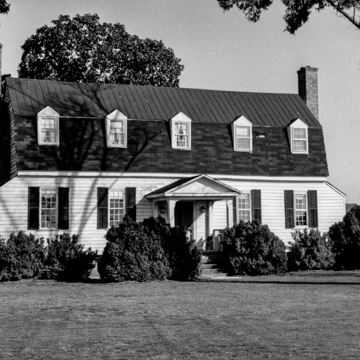Rising from the flat fields around it, this five-bay frame house with its gambrel roof presents a striking profile. Its owner was Captain Henry Harrison, a soldier in the French and Indian War. His brother, Benjamin, was a signer of the Declaration of Independence, the father of President William Henry Harrison, and the grandfather of President Benjamin Harrison. Built by a relatively affluent owner, this midsize plantation dwelling is single-pile with a center-passage plan. On each side of the exterior-end brick chimneys are pents. Five gabled dormers punctuate the gambrel roof. The one-bay front porch dates from the mid-twentieth century. Worked by thirty to forty slaves throughout the late eighteenth and early nineteenth centuries, the plantation produced corn and wheat and raised cattle, hogs, pigs, and sheep. Captain Harrison also bred thoroughbred horses, including his famed Silver Heels.
You are here
Hunting Quarter
If SAH Archipedia has been useful to you, please consider supporting it.
SAH Archipedia tells the story of the United States through its buildings, landscapes, and cities. This freely available resource empowers the public with authoritative knowledge that deepens their understanding and appreciation of the built environment. But the Society of Architectural Historians, which created SAH Archipedia with University of Virginia Press, needs your support to maintain the high-caliber research, writing, photography, cartography, editing, design, and programming that make SAH Archipedia a trusted online resource available to all who value the history of place, heritage tourism, and learning.















